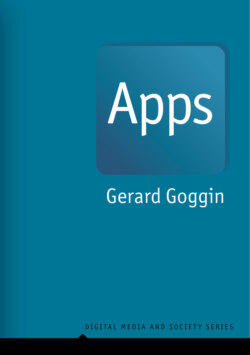Читать книгу Apps - Gerard Goggin - Страница 8
The Apps Pivot in Digital Media and Society
ОглавлениеTo make sense of the heady career of apps, I advance five key arguments in the chapters that follow.
First, as elaborated in chapter 2, I discuss the fundamental identity of apps as a kind of software. Like all software, apps have a relationship—and are in dialogue—with the hardware that their code operates as well as with the environments in which both the software and the hardware are situated. While apps have enormous variety and flexibility, they also operate within distinct constraints. Within these limits, apps offer an important bridging of digital media and society: they provide fabric for the sociotechnical systems and infrastructures that characterize many digital societies, as these have taken shape in recent years and are evolving toward the future.
Second, apps are often excitedly promoted as paving the way for wonderful kinds of innovation, woven together with new kinds of economics business models, which typically involve the catchall notion of entrepreneurship. Yet such apparently limitless potential is clearly offset by the fact that apps exist within systems of value, power, and control. At various levels, especially at the level of their construction, design, and affordances, apps constrain their users just as much as they enable them, if not more. Apps often channel their users, uses, and meanings into distinct social relations, economies, and politics. This is the argument I make in chapters 3 and 4, which trace the political and cultural economy of apps, their implication in geopolitical shifts, and the creation of new infrastructures and forms.
Third, in an extraordinarily creative way, apps are pivotal to a teeming field of media innovations; this is something I discuss in chapter 4. App media build on many of the aspects of computers, software, and code applications before the smartphone era. Since the early 00s at least, and indeed well before the turn of the century, apps as media have supported, framed, and mediated our contemporary developments centered on data, algorithms, machine learning, and AI. Taking a wider view still, it is remarkable how apps have been crystallized and have driven innovations across a very wide range of media. In part, these app media innovations have to do with interactions and development in social life and technology that center on the rise of various digital media forms—games, video sharing and streaming, camera, images, visuals, text, language, messages, sound, audio, music, voice, and so on. A reflex focus of many actors in these process as well as of commentators has often been on the app itself: its design, development, marketing, user acceptance, and viability. However, the app is often just the tip of the iceberg. The app helps create a new media form, but it does so as a portal, entry point, or strategic node in a larger system and assemblage.
Fourth, for better or worse, apps function as social laboratories; this is the subject of chapter 5. Apps are fabrics that help media stretch into new shapes, and they also expand our ideas of what functions media can perform. The myriad media of apps infiltrate everyday life in new ways. All around the world, apps have been seized or used to make do as resources for projects of social change. They can be pivotal in infrastructures that underpin political, social, and cultural change. The social laboratories of apps operate at a huge range of scales, which run from the small worlds of our ordinary lives through the meso levels of organizations, institutions, subcultures, communities, and publics to the macro levels of national, regional, and global settings.
Fifth, because of characteristics of apps outlined in these four arguments, we need to talk about apps and take their functions, implications, and potentials seriously, yet skeptically. There have been many anxieties raised by apps and their deleterious impacts on work–life balance, mental health, relationships and intimacies, misinformation and fake news, hate speech, extreme content, bias, discrimination, and inequalities, not to mention the future of cultural diversity, or accessible and affordable media. However, apps have been hard to pin down. They seem to be everywhere—“there’s an app for that”—and yet they are kinda boring—just part of the digital and social furniture. Issues of values, politics, and policy associated with apps early on—such as the enclosure and control represented by the advent of app stores, the role of apps in the creeping commodification of culture and media, and then across swathes of social life—were slippery and hard to pin down.
Apps debates have changed dramatically in recent years. One obvious area of concern is the extension of data into many areas of human, built, and natural environments. Datafication has been widely discussed and critiqued. Apps are not just a bit player in the politics of data infrastructures, algorithms, and AI, as we can now see vividly from the wide and deep global and local issues raised by the entrenchment of what has been called “digital platforms.” We don’t have a clear sense so far of where apps fit into this global landscape, where media and communications offer enormous scope for advancing social progress, equality, justice, rights, and other important values and goals, yet the countervailing realities and future scenarios appear very bleak. By way of concluding the book, I look at the role of apps in the grand social project of putting media and communications firmly back in people’s hands.
